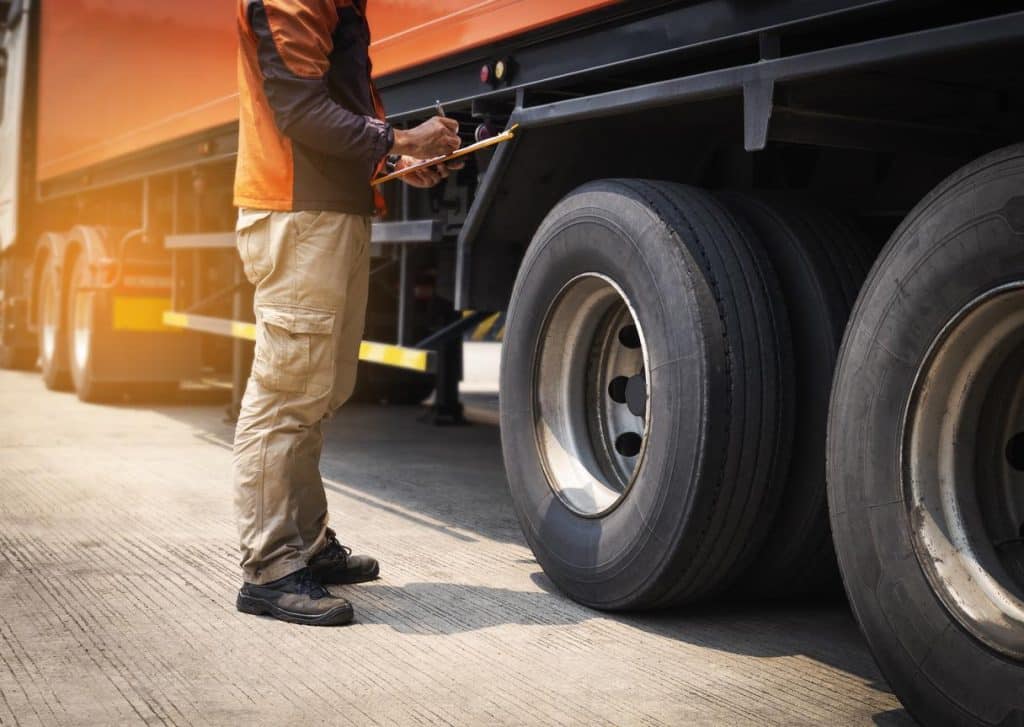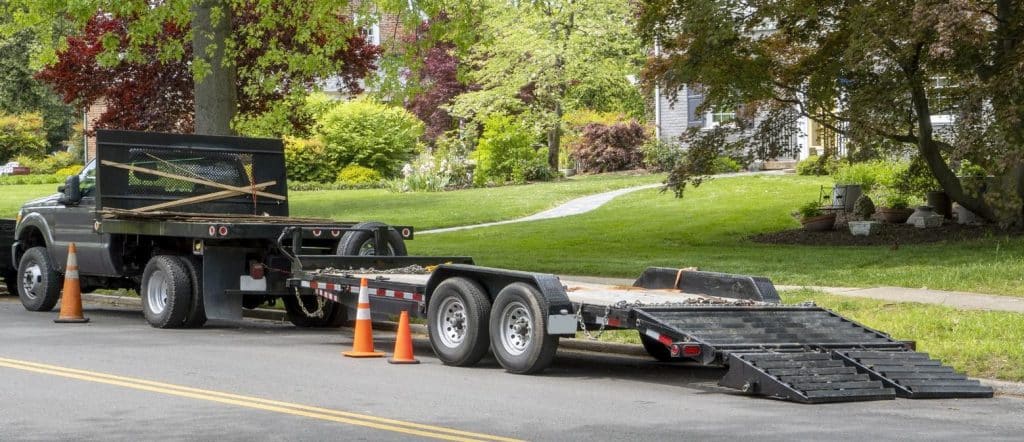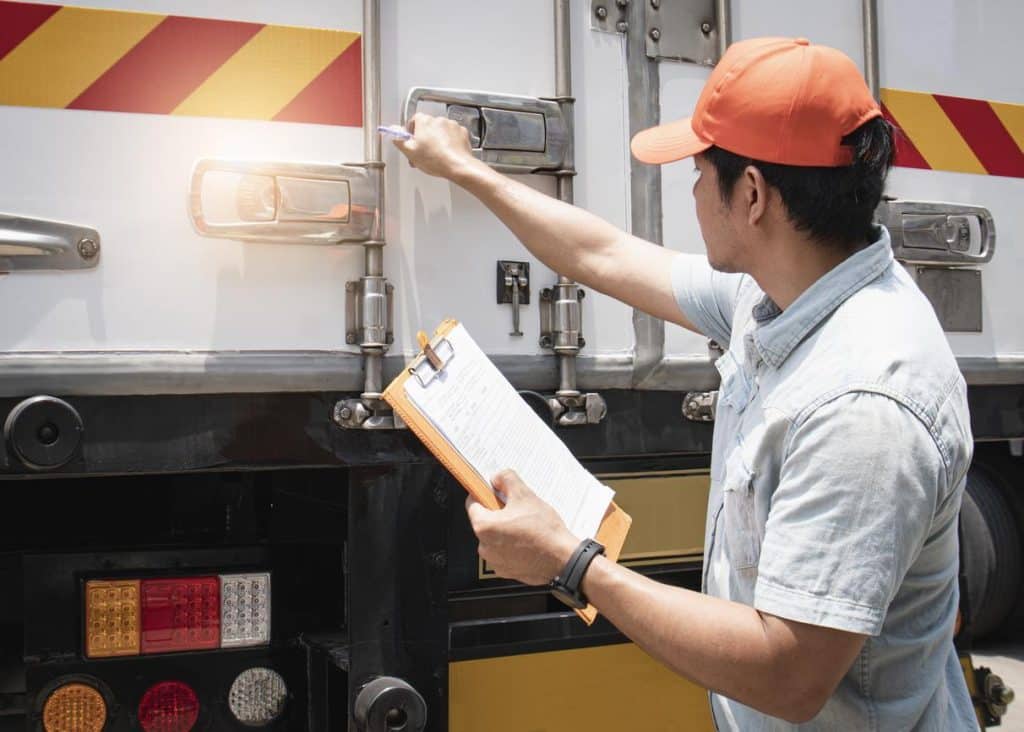
Commercial trailer inspection should occur before use and on a scheduled and routine basis. Depending on the nature of the use, a mid-trip assessment might also become necessary. Inspections should include a visual of the trailer’s deck, brakes, tires, ramps, hoses, connections, and lights (at the bare minimum). To find out all the details, you’ll have to read on.
In this guide, we’ll discuss the standard regulations for trailer inspections and provide insights into the best practices for managing trailers within your commercial fleet. We’re going to review rules for North America, from Canada down to Mexico (and, of course, the United States). So, without any further ado, let’s get started.
Commercial Trailer Inspections – Why Bother?

Logistics and transport management is organizing and overseeing the transportation of goods. It includes ensuring that everything runs smoothly and that all necessary paperwork is filed correctly.
When I say it runs smoothly, I’m insinuating that it’s a requirement to follow regulations about trailers, and train drivers, appropriately, and importantly, inspect and repair trailers as required.
However, there are several benefits to regularly inspecting your commercial trailers aside from the obvious legal and legislative requirements.
Regular trailer inspections can help logistics operations by ensuring that vehicles operate correctly and efficiently. Proper maintenance of trailers ensures that the transported goods arrive safely and on time and reduces the risk of costly repairs or replacements for faulty equipment.
Documentation of regular commercial trailer inspections also helps fleet managers keep track of maintenance and repair schedules. It helps by improving visibility into overall logistics equipment performance. Furthermore, it can make the process more cost-effective when correctly deployed by avoiding unnecessary repairs or replacements due to negligence or wear and tear.
When commercial trailer inspection is managed correctly with best practices in mind, logistics operations benefit significantly from increased safety and efficiency.
Commercial Trailer Inspection Frequency
Commercial trailers need regular inspections to work correctly and ensure the transported goods arrive safely. It also helps the fleet manager know when a trailer needs repairs.
Depending on the region where the trailer will travel, several different and specific trailer inspection frequencies are required. Generally, however, we can follow a simple guide:
- Inspect before use.
- Inspect daily (during multi-day trips, this daily inspection is critical).
- Inspect monthly (if left dormant).
- Inspect annually.
According to the FMCSA, any combination of vehicle plus trailer that exceeds 10,000 pounds in combined weight is subject to the rules and regulations of FMCSR.
Check with local authorities and authorities in all areas of travel to ensure proper inspection frequency and documentation occurs consistently and correctly. We’ll provide more information further down in the regulations by country section.
Commercial Trailer Inspection Types

There are several types of towable trailers, so several types of inspections exist. Here are the five most common types of trailer inspections, regardless of type.
- Manufacturing quality control inspection
- Purchasing/1st Use Inspection
- Daily and Pre-Use Inspections
- Monthly and Idle Inspection
- Annual and Safety Inspections
Manufacturing Quality Control Inspection
Manufacturing requirements typically insist on rigorous quality control inspections for trailers before the trailer’s release for sale. Similarly, trailers manufactured, shipped, and sold might require specific care and attention by registered dealers before the sale. In this case, two quality control inspections may be completed on a new trailer.
When your organization buys a trailer, you should receive some form of documentation of the manufacturer’s quality control inspection. If not, the dealer will likely provide a pre-sale inspection of the trailer, which should act as a manufacturer’s quality control equivalent. In this case, you’ll need to ensure your warranty coverage is appropriate, given the complexity of the final quality check of your new trailer.
Purchasing/1st Use Inspection
After your organization purchases a trailer, you should commit your team to an appropriate initial inspection and test of the new trailer. The examination should look for defects in quality and manufacturing. Similarly, you’ll want to ensure all components are appropriately tightened, lubricated, and installed, as the case may be.
The documentation of the first-use inspection or the first post-purchase inspection is critical to complete, ideally before signing off on the final sale of the trailer, but at the very least immediately after the sale, so if any warranty claims arise, they do so efficiently after purchase. Companies are more likely to rush and provide a great service fixing issues when it’s closer to the point of sale.
Daily And Pre-Use Inspections
Some of what we consider essential inspections for commercial trailers are also the most common. These inspections are daily and pre-use trailer inspections.
Training your team to perform inspections is easy using a tool like the 1st Reporting app. It also makes managing the inspection results a lot easier. Still, we’ll get to that more later when we discuss how to make the trailer an easy part of fleet management and how you can do your entire job managing any inspection easily.
Daily and pre-use inspections are critical because these are typically performed by the people towing the equipment. That means the person is highly engaged in responsible practices as their life and limb are literally at stake. Due to the heavy personal responsibility, these daily and pre-use inspections are some of the most honest and trustworthy sources of equipment reporting. Well, most of the time, that is. Take it with a grain of salt depending on the driver, but if you ensure thorough training for your team and a robust inspection solution like an excellent trailer inspection checklist or the preferred digital inspection app, 1st Reporting.
Monthly And Idle Inspections
Vehicles and equipment that sit idle for extended periods will require special attention. Trailers that sit out in the sun can heat up. Over time, with hot sun, lubricants, greases, and other items on a trailer can slowly run and lose effectiveness.
Like grease and oil slowly losing effectiveness from the sun’s heat and time, rubber hoses degrade, and even rubber tires degrade over time. Sunlight’s powerful ultraviolet rays accelerate
this degradation.
To ensure proper running order, scheduling monthly or quarterly inspections for idle trailers is a good idea. Similarly, you’ll be able to catch wearing components like rubber hoses and such before finding them fail the next time the trailer goes out on the road.
Annual And Safety Inspections
Annual and safety inspections both require a professional and sometimes a government-certified inspector. However, even if you aren’t a government inspector or a certified independent inspector, you can still use the same inspection tools and methods to complete in-house inspections.
In-house annual and safety inspections for equipment like trailers ensure the quality and safety of the trailer. It also significantly increases your chances of passing any inspections mandated by officials like the DOT. And maintaining a clean DOT inspection record can mean more significant savings on insurance. So, it’s well worth scheduling annual in-house inspections of your trailers to the extent that your operation is equipped to complete.
Commercial Trailer Inspection Regulations
Regulations for commercial trailers are the responsibility of the state, province, or territory. That means that whatever region the trailer will travel to, it must abide by the local regulations of that region.
So who governs these rules and regulations? Are they different across regions?
The answer, luckily, is that in North America, there are a series of regulations regarding the standards of trailer components. In essence, if each component meets a required standard, then by way of association, a complete trailer must meet a certain minimum standard by way of the total of its features.
Most trailer coupling components must meet standards outlined in ISO/TC 22/SC 40 for light and heavy commercial vehicles, buses, and trailers.
Each region and country have specific regulations and requirements for inspecting their road-worthy products, such as trailers. Generally speaking, most regions have the same rules, but the specifics may differ. For example, in the United States, it’s common to see that the combined weight of a vehicle and trailer of 10,000 pounds or more requires certification and annual inspection. In Canada, the rules apply by provincial legislation that follows federal guidelines, but mandating the rules occurs on the provincial level. In Ontario, for example, trailers require an annual safety inspection (good for twelve months) if the trailer or combination of trailer and towing vehicle are more than 4,500 kg. That is to say; the gross vehicle weight rating is greater than 4,500 kg.
As you can see, both the United States and Canada follow the same rules, but the specifics differ (4500 kg = 9920.802 lb while 10,000 lbs = 4535.924 kg).
Let’s look at some of the specific trailer inspection requirements per country.
Canada
CVOR or the Commercial Vehicle Operator’s Registration is a mandatory requirement in Ontario, Canada. Quebec similarly requires US carriers to apply for and obtain registration via their Registration Identification Number. Neither province will allow carriers to transport trailers unless those requirements are met. The other provinces and territories follow their regulations for allowing international trailers into their regions, but Ontario and Quebec are the most strict within the country.
In order to obtain either a CVOR or RIN in Ontario or Quebec, trailer owners must schedule a safety inspection through government-certified inspection providers. The CVOR or RIN is a requirement before entering the provincial regions.
As mentioned, each province manages its plating and inspection requirements for trailers. However, most provinces and territories require that any commercially used trailer also passes an annual safety inspection performed by a certified inspector. In Ontario, many mechanic shops are capable of offering such inspections.
United States of America
In the United States, if your organization utilizes trailers of any kind, then pay attention. If your driver is pulled over and issued a roadside inspection report by an officer of the state department of transportation or an authorized agent of the FMCSA, then the following applies.
Within 15 days after the inspection, all violations must be reported as corrected. The authorization of completion is via a signature on the report. You must keep a copy of the report on file for at least 12 months from the inspection date.
So, how often should you inspect your trailer? Regularly inspecting your trailer ensures a significant advantage in preventing roadside inspection reports demanding costly emergency measures.
However, regarding the regulation and frequency of inspections, like Canada, the United States utilizes regional inspection requirements that follow federal guidelines.
Any vehicle plus trailer combination with a gross weight greater than 10,000 lbs must pass an annual DOT safety inspection. Each state regulates where you can get the inspection and by whom.
Mexico
As you know, there’s a lot of truck traffic going across the borders of North American countries, and Mexico is no exception. In March 2016, the FMCSA announced they accepted Mexico’s annual inspection criteria for trucks and trailers. The Mexican inspection criteria are similar enough to the United States that following the same rules will keep you out of hot water. Still, it’s best to check with the respective state authorities in Mexico before traveling with a commercial trailer.
Inspections Based On Trailer Types
Different inspections become necessary depending on the trailer type and the use type. However, it isn’t easy to categorize inspections based on trailer type due to the varying uses of a single trailer type.
For example, a tanker trailer might haul gasoline, chemicals, or even milk to drink. You wouldn’t perform the same inspection for a food-grade tanker as for a tanker that carries chemicals or gas.
Therefore, the type of trailer might be the same, but the intended use dictates more about the kind of inspection the trailer requires.
There are, however, specific items of note that only specific trailer types will have. Returning to our tanker trailer example above, let’s now add a low-bed equipment transport trailer used for hauling excavators. Although both are towable trailers, the differences are as clear as night and day.
Due to the vast amount of trailer types and uses, it’s best to use a customizable inspection template solution like 1st Reporting for your trailer inspection documentation needs.
Inspection Frequency
Depending on the use of the trailer, there are several different frequencies that you must consider regarding the commercial trailer inspection requirements.
| Inspection Frequency | Requirement | Recommendations & Tips |
| Before use. | New trailers often need government inspection and safety certification | Check with local transportation officials about pre-use safety certification |
| Daily | Drivers are required to inspect trailers for safety before use in most regions. | Use a daily vehicle walk-around template, trailer inspection checklist, or app to document |
| Weekly | A weekly trailer inspection might be a good idea, depending on trailer use frequency. | Maintain trailer inspection documentation with a robust solution like the 1st Reporting app. |
| Monthly | A weekly trailer inspection might be a good idea, depending on trailer use frequency. | Maintain trailer inspection documentation with a robust solution like the 1st Reporting app. |
| Annually | Annual inspections and certification are standard requirements in most regions. A yearly trailer safety inspection is necessary for commercial operations in most countries. | Government regulatory bodies or appointed independents perform safety inspections. Usually, a trailer mechanic or sales shop will offer trailer safety certification. |
Commercial Trailer Inspection Management

Managing a fleet of drivers, loaders, and unloaders (and no doubt a plethora of others), we know you’ve already got your hands full. Worrying about towing equipment like low-bed trailers, for example, isn’t something you should spend your energy on. However, you need a system that works. That’s why you must ensure two vitally essential criteria are met.
- You have the process in place to fulfill the inspection goals.
- You have the tools in place to fulfill the requirements of the inspection process.
The Inspection Process
Validating your inspection process by creating a systematic documented approach is an intelligent way of managing. Similarly, establishing a specific process allows you to test the operation for errors and ensure that weaknesses are amended.
Many inspection processes are easy to implement a definitive methodology to their deployment. Utilizing the right tools can help, like procedural checklists, for example. But we’ll talk more about that next.
The primary inspection process must involve the following steps or stages.
Identification Of Equipment Parameters
The first vital step to any trailer inspection is identifying the trailer information. This information includes the type and purpose of the trailer, as well as tire information, capacity limits, and the date of the last inspection.
Visual Inspection Of Equipment
Secondary to equipment data collection is the visual inspection of the trailer. This stage typically looks for obvious concerns like damage, leaking hoses, or other visually apparent signs of trouble.
Physical Inspection Of Equipment Where Possible
Wherever possible, trailers’ physical components should be inspected and tested. The test might include operating powered ramps to ensure proper functionality. Or it might mean testing the landing gear equipment to ensure proper operation.
Verification Of Equipment Status
Finally, any inspection must conclude whether the equipment is safe for use or requires further maintenance or repair. This stage is vital to the inspection process because it completes the funnel of information garnered from the inspection. It is the summary of findings and the final pass or fails for the trailer’s current use.
Inspection Tools
Using the right tools for the job isn’t something we need to tell you – you know this to be true. But do you know what the best tools for a trailer inspection include? We recommend a few tools to make the trailer inspection process much easier to manage and deploy.
- Safety Equipment – Pylons, a hard hat, a safety vest, safety boots, and safety glasses are a few of the items that we recommend. It would be best if you kept the inspector safe. So, if you can inspect the trailer indoors, out of the way of yard traffic, all the better (as long as you don’t replace yard traffic with forklift traffic).
- A Good Flashlight – Unless you’ve got some excellent vision, a flashlight will come in handy to see the trailer’s undercarriage. Without it, you’re looking in the dark shadowy underbelly of a trailer without a hope of seeing things.
- A Trailer Inspection Checklist – A checklist ensures that all points on the trailer are appropriately inspected. We’ve got some great checklists in our template library that you can download and use today. However, if you want an even better solution, try leaving the pen and paper on your desk and using a phone or tablet instead. Here’s how.
Inspection App – The 1st Reporting Way
If you aren’t a fan of dirty paperwork, bad handwriting, or lost inspection reports, you will want to read this. Technology has allowed us to take pen and paper and leave them with the 8-track to sleep in history. And we’ve worked hard to ensure that our solution to replace paper checklists and inspection reports does so much more that you’ll wonder why you didn’t make the switch sooner.
Let’s get to the point – the 1st Reporting app lets you:
- Build custom forms for any purpose
- Assign team members to complete forms
- Set up automatic notifications, so specific forms send a message to the suitable supervisor when completed.
- Collects form submissions and stores them securely on the cloud
- Provides an easy-to-use interface for my entire team
- Integrates with Microsoft Teams®
Seriously, you’re going to want to try this app for yourself. Book a free demo, or download the app on Google Play or The Apple App Store and see the difference.